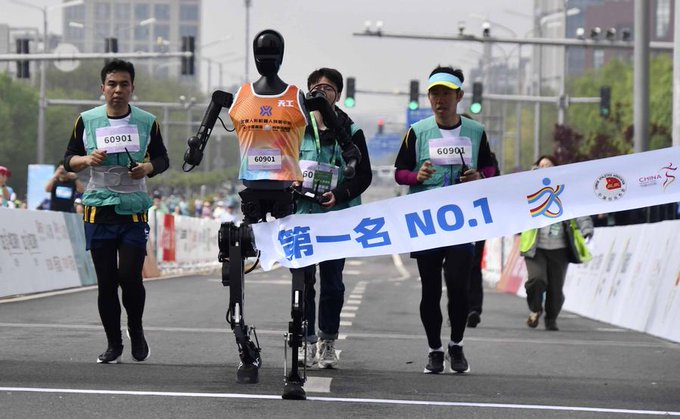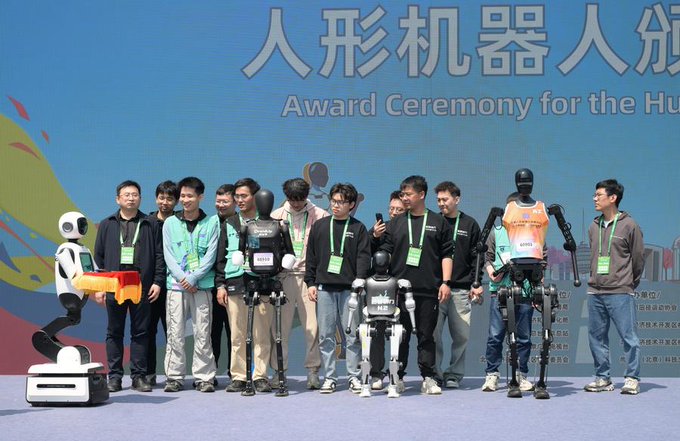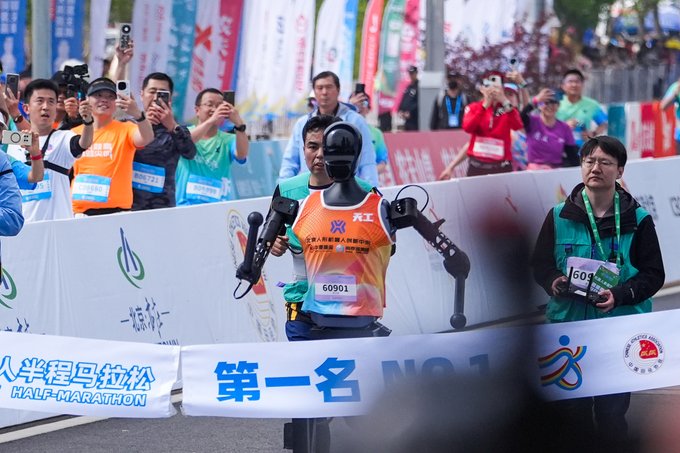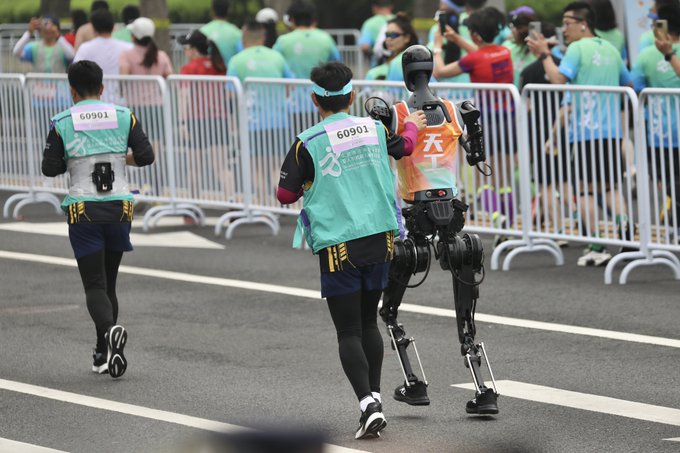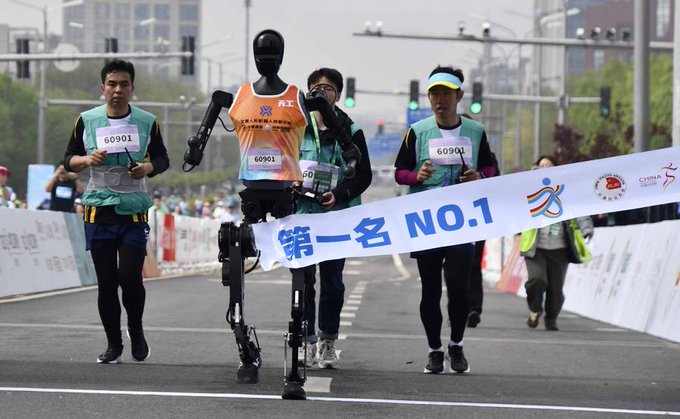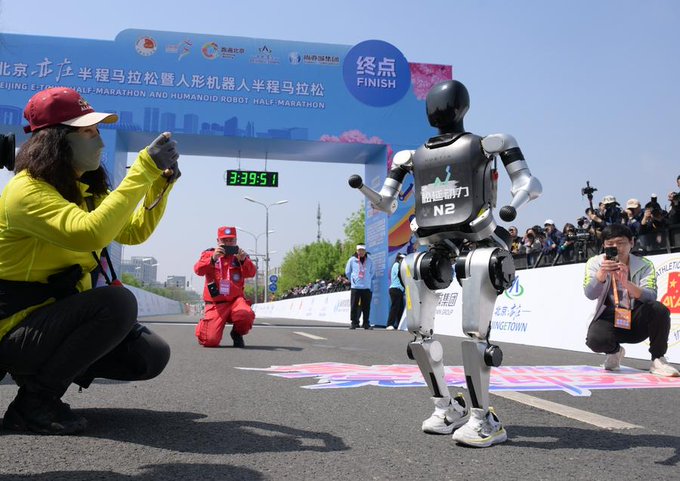Beijing, China— The future just sprinted 21 kilometers through the streets of Beijing — and it didn’t even break a sweat.
In a world-first fusion of artificial intelligence, robotics, and athletic competition, humanoid robots successfully completed a half-marathon over the weekend, proving that bipedal bots aren’t just built for factory floors anymore — they’re coming for our finish lines too.
Held in the Beijing Economic-Technological Development Area, the event marked the first time humanoid robots have competed in a half-marathon globally.
And no, this wasn’t just for show — these bots tackled everything from gravel paths to speed bumps, all while sticking to a dedicated race track beside their human counterparts.
Outfitted with precision engineering and high-octane endurance algorithms, 20 humanoid robots laced up (figuratively) for the 21.0975-kilometer challenge.
Humanoid robots completed their first global half-marathon in Beijing on Saturday, with Tiangong Ultra, developed by the Beijing Humanoid Robot Innovation Center, claiming victory with a time of 2 hours, 40 minutes, and 42 seconds—leading the 21.0975 km race among 20 teams.
Each bot ran with the support of a pit crew of engineers, operators, and AI wizards — think NASCAR meets Boston Dynamics.
The showstopper? Tiangong Ultra, a 1.8-meter-tall, 55-kilogram bot developed by the Beijing Humanoid Robot Innovation Center, which crossed the finish line at a breezy 2 hours, 40 minutes, and 42 seconds. Not bad for a first-timer, and a solid 30 minutes ahead of schedule.
“This wasn’t just about speed,” said Xiong Youjun, the center’s CEO. “We tested durability, terrain adaptation, and technical design — and the robots nailed it.”
These weren’t carbon copies either. Some robots emphasized sleek motion, others showcased expressive features or specialized footwork. Like a catwalk meets a tech demo — except everyone’s sweating circuits instead of Chanel.
🚨🤖🏅 “Tiangong Ultra” clinched the WORLD’S FIRST humanoid robot half-marathon title with a time of 2h40m in Beijing E-Town!📌 Race Highlights: 20 teams participated | “Human-robot co-run” format🔋 Rules: Battery swaps & repairs allowed (time counted toward results).
The Race Was Real, and So Were the Tech Hiccups
Despite the success, it wasn’t all smooth jogging. During a trial run, a screw in one robot’s ankle gave out just 6 kilometers short of the finish line. Quick-thinking engineers patched it up with three new positioning pins, and voilà — zero issues since.
The robots had to adjust their gaits in real time as the course wound through Nanhaizi Park and Wenbo Bridge, covering cracked pavement, rolling hills, and grassy segments.
Every surface required microsecond recalibrations in stride, posture, and balance — pushing even the most advanced locomotion systems to their limits.
Power swaps? Picture Formula 1-style pit stops where robots quickly docked for a fresh battery and zipped back onto the track.
To keep things fair, the event featured awards beyond just speed: Best Gait Design, Most Innovative Form, and Endurance Champion rounded out the podium. Think of it as the Oscars for robotic athletes.
This wasn’t just a PR stunt or a quirky one-off. Saturday’s event was a strategic move by China to showcase its growing dominance in embodied intelligence — AI that’s not just smart but physically present in the real world.
According to China’s Ministry of Industry and Information Technology, the country holds over 190,000 valid robotics patents, or roughly two-thirds of the global total.
Humanoid robots completed their first global half-marathon in Beijing on Saturday, with Tiangong Ultra, developed by the Beijing Humanoid Robot Innovation Center, claiming victory with a time of 2 hours, 40 minutes, and 42 seconds—leading the 21.0975 km race among 20 teams.
The government recently tagged humanoid robots as a core technology for future industries, with applications ranging from smart manufacturing and eldercare to education and extreme environment operations.
The market potential? A cool 870 billion yuan (about $119 billion USD) by 2030, according to forecasts by the China Electronics Society.
“Robots completing the race isn’t the finish line,” said Liang Liang, Deputy Director of Yizhuang’s Administrative Committee. “It’s the launch pad for deeper industrial collaboration, smarter tech, and new global benchmarks.”
Even Zhao Fuming, director of the Beijing Marathon Association, sees a broader application: “They won’t always run beside us — they might help with security checks or even guide runners along the course.”
While Ethiopia’s elite runners took the crown in the human half-marathon on the same day, the real buzz was about the bots.
What we saw wasn’t just a novel tech showcase — it was a preview of how AI and robotics are evolving from code and concept into kinetic reality.



